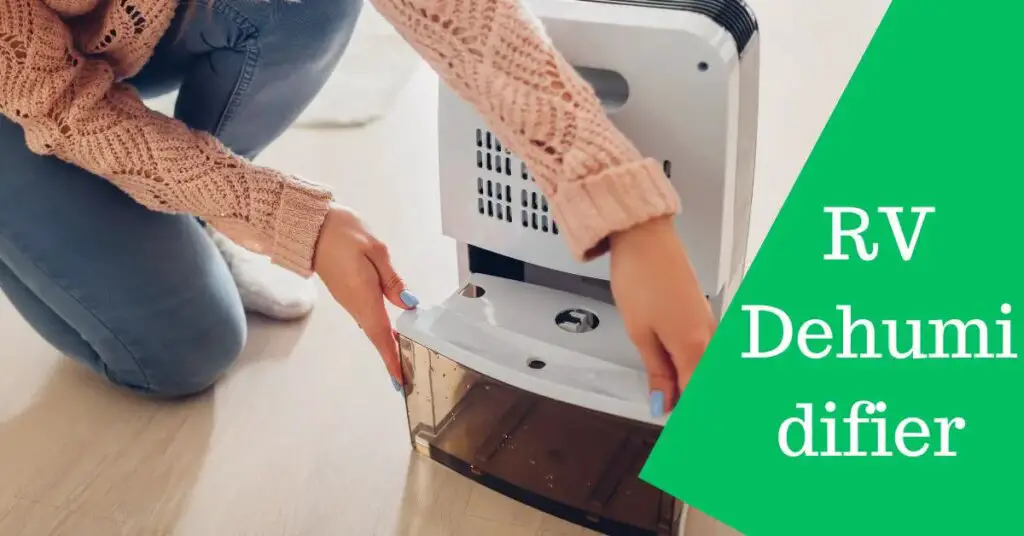Humidity is an enemy for small places like inside RVs. If you opt to buy a dehumidifier, where is the best place to put a dehumidifier in an RV? Let’s find out your ideal place with these helpful tips.
Whether you’re a full-time RVer or simply enjoy the occasional road trip, keeping moisture levels in check is essential for maintaining a comfortable and healthy environment inside your recreational vehicle.
In this article, we explore the question that often arises: Where is the best place to put a dehumidifier in an RV?
Join us as we uncover the most strategic locations to deploy this handy appliance, ensuring optimal moisture control and a more enjoyable RV experience. Let’s dive in!
Table of Contents
Where Is the Best Place to Put a Dehumidifier in an RV?
To maintain balanced humidity levels, it is recommended to position the dehumidifier at least 12 inches away from walls and other objects. This allows for proper airflow and circulation. It’s important to avoid placing the unit near window panes or drafty areas, as this can lead to cold air entering the dehumidifier, potentially affecting its performance.
What is Dehumidification in an RV?
Dehumidification in an RV refers to the process of reducing and controlling the moisture levels within the interior of the recreational vehicle. Due to the compact nature of RVs and their exposure to varying weather conditions, humidity can quickly accumulate and lead to a range of issues.
Excessive moisture can cause mold growth, musty odors, condensation on windows and walls, and even damage to furniture and fixtures. It can also create an uncomfortable and unhealthy living environment for the occupants.
To combat these problems, RV owners often turn to dehumidifiers. A dehumidifier is an electrical appliance designed to extract excess moisture from the air, helping to maintain a balanced humidity level inside the RV. By removing moisture, dehumidifiers prevent the formation of mold and mildew, improve air quality, and promote overall comfort.
Dehumidifiers in RVs typically work by drawing in moist air, cooling it to condense the moisture, and then collecting the water in a reservoir or draining it outside the vehicle. They come in various sizes and types, such as portable units or built-in systems, allowing RV owners to choose the most suitable option for their specific needs.
Proper dehumidification in an RV is crucial for ensuring a pleasant and healthy living space, especially in regions with high humidity or during seasons when moisture levels are elevated.
Why RVs Need Dehumidifiers
RVs require dehumidifiers for several reasons. Let’s explore some of the challenges that arise in maintaining optimal humidity levels in an RV and the benefits of using dehumidifiers:
Preventing mold, mildew, and musty odors
Due to RVs’ compact and enclosed nature, moisture can quickly accumulate, especially in areas prone to high humidity or during rainy seasons. Excess humidity provides an ideal breeding ground for mold and mildew, which cause unpleasant odors and pose health risks to occupants.
Dehumidifiers help to reduce humidity levels, inhibiting the growth of mold and mildew and preventing musty odors from permeating the RV.
Protecting furniture, fabrics, and electronics from moisture damage
Excessive moisture in an RV can damage furniture, upholstery, carpets, and electronics. Wood can warp or rot, upholstery can develop stains or mold, and electronics may malfunction or corrode.
By using a dehumidifier, the moisture content in the air is reduced, minimizing the risk of damage to these valuable components of the RV.
Improving air quality and comfort
High humidity levels can make the air feel damp and uncomfortable inside an RV. It can also exacerbate respiratory conditions and allergies.
Dehumidifiers help to create a more comfortable and healthier living environment by reducing excess moisture in the air, improving air quality, and promoting better respiratory health for the occupants.
Preventing condensation
Condensation can occur on windows, walls, and other surfaces when warm, humid air comes into contact with cooler surfaces. This can lead to water droplets forming, which can eventually cause water damage and mold growth.
Dehumidifiers work to minimize condensation by controlling the humidity levels, and preventing the formation of excess moisture on surfaces.
Using dehumidifiers in RVs is crucial for maintaining optimal humidity levels, preventing mold and mildew growth, protecting furniture and electronics from moisture damage, and creating a more comfortable and healthy living space.
Factors to Consider When Placing a Dehumidifier in an RV
Size and capacity of the dehumidifier
The size and capacity of the dehumidifier should match the dimensions and moisture load of your RV. Consider the square footage of the space you want to dehumidify and choose a dehumidifier with an appropriate capacity to remove moisture effectively.
Climate and location
The climate and location of your RV travels play a significant role in humidity levels. If you frequently visit humid regions or experience high humidity, you might need a more powerful dehumidifier. Likewise, a smaller unit or intermittent use might suffice if you often travel to dry areas.
Ventilation and air circulation
Proper air circulation helps the dehumidifier to operate efficiently. Ensure that the chosen location allows for adequate airflow around the dehumidifier.
Placing it near a vent or in a central area of the RV can help distribute dry air more evenly throughout the space.
Water source and drainage
Consider the availability of a water source for the dehumidifier. Some units have built-in reservoirs that require periodic emptying, while others offer continuous drainage options.
Ensure that the dehumidifier’s drainage method aligns with your RV’s infrastructure and convenience.
Noise considerations
Dehumidifiers generate some level of noise during operation. Take into account the noise tolerance of the occupants and choose a location that minimizes disruptions. Consider placing the dehumidifier in a less frequently used area or one with soundproofing options.
By considering these factors, you can determine the most suitable placement for your dehumidifier, ensuring optimal performance and effective moisture control in your RV.
Places Considered to Put a Dehumidifier in an RV
Kitchen Area
Placing a dehumidifier in the kitchen area can help combat moisture generated during cooking and washing dishes. It prevents excess humidity from spreading throughout the RV, reducing the risk of condensation and mold growth.
Countertop or portable dehumidifiers are suitable for this area, providing convenience and easy access to water drainage.
Bathroom
The bathroom is another space prone to high humidity due to showers, sinks, and limited ventilation.
Installing a wall-mounted or compact dehumidifier in the bathroom helps control moisture levels, preventing the formation of mold and protecting bathroom fixtures. Look for models designed for smaller spaces and with moisture-resistant features.
Bedroom
A comfortable and moisture-free sleeping environment is essential for a restful night’s sleep.
Placing a dehumidifier in the bedroom helps maintain optimal humidity levels, reducing the likelihood of clammy sheets or musty odors. Opt for quiet and energy-efficient dehumidifiers that won’t disrupt sleep.
Living Room
The living room is often the central gathering space in an RV, and it’s essential to protect furniture, upholstery, and electronics from excess moisture.
Consider placing a dehumidifier in the living room to control humidity levels, ensuring the longevity and preservation of these items. Look for discreet and aesthetically pleasing dehumidifiers that blend well with the decor.
Storage Compartments
RVs typically have storage compartments for stowing belongings during travel. These areas are susceptible to moisture accumulation, potentially damaging stored items.
Utilize compact and portable dehumidifiers specifically designed for small spaces. These dehumidifiers can help prevent moisture damage and maintain the condition of your stored belongings.
Closet Spaces
Closets are prone to musty odors and mold growth due to limited ventilation. Installing compact and battery-operated dehumidifiers in closets helps maintain dry conditions, protecting clothes and other stored items from moisture damage.
Basement or Underbelly
RVs with basements or underbelly storage areas can experience increased moisture levels. Consider specialized dehumidifiers designed for basements or underbellies to manage moisture in these lower areas effectively. These dehumidifiers are often more robust and capable of handling larger spaces.
Overhead Cabinets
Excess humidity in overhead cabinets can affect dishes, food items, and utensils. Placing small and discreet dehumidifiers within the cabinets can help maintain a dry environment and prevent moisture-related issues.
Entryway
Entryways are susceptible to moisture buildup due to frequent opening and closing of doors. Portable or mini dehumidifiers strategically placed near the entryway can mitigate moisture accumulation and prevent it from spreading into the rest of the RV.
Window Areas
Windows are common areas for condensation and moisture buildup. Select dehumidifiers equipped with window kits or attachments to target these specific areas effectively.
These kits allow the dehumidifier to collect moisture from the windows directly, reducing the risk of condensation and maintaining clear views.
Consider each area’s unique characteristics and requirements when selecting dehumidifiers for these locations. Compact, discreet, and specialized dehumidifiers will prove beneficial in managing moisture levels and protecting various aspects of your RV.
Toshiba Dehumidifier TDDP5013ES2
How to Keep Mold Out of Camper During Storage
Keeping mold out of your camper during storage is crucial to ensure a clean and healthy environment when you’re ready to hit the road again.
Thoroughly clean and dry the camper
Before storing your camper, give it a deep cleaning, ensuring all surfaces are free from dirt, debris, and any existing mold.
Pay close attention to areas prone to moisture, such as the bathroom, kitchen, and storage compartments. Once cleaned, allow the camper to thoroughly dry before closing it up.
Remove all food and perishables
Make sure to remove any food items, perishables, and trash from the camper before storage. Mold thrives on organic matter, so eliminating potential food sources reduces the risk of mold growth.
Empty and clean water tanks and lines
Drain and clean the fresh water tanks, as well as any other water lines or systems in your camper. Stagnant water can become a breeding ground for mold, so it’s essential to eliminate any moisture sources.
Reduce humidity levels
Lowering the humidity inside the camper is crucial in preventing mold growth. Consider using dehumidifiers or moisture absorbers throughout the storage period. If possible, keep the camper in a dry and well-ventilated storage area.
Use desiccant packets or moisture-absorbing products
Place desiccant packets or moisture-absorbing products strategically inside the camper to absorb any residual moisture. These products are particularly useful in enclosed spaces such as closets, cabinets, and storage compartments.
Cover and protect the camper
Use a breathable cover to protect your camper during storage. A breathable cover allows air circulation, preventing moisture buildup inside while keeping dust and debris out.
Regularly inspect and air out the camper
Whenever possible, visit your camper during storage and inspect it for any signs of mold or moisture. If you notice any issues, address them promptly. Additionally, take the opportunity to air out the camper by opening windows and doors to promote fresh air circulation.
Consider using mold-resistant products
When cleaning and maintaining your camper, opt for mold-resistant products such as cleaners and sealants. These products help inhibit mold growth and provide an additional layer of protection.
Frequently Asked Questions
Where should you position a dehumidifier?
Ideally, position a dehumidifier in an area where it can effectively circulate air throughout the space. Common locations include the kitchen, bathroom, bedroom, living room, and storage compartments.
Consider areas prone to high humidity or moisture buildup. Additionally, ensure that the dehumidifier is placed in a convenient spot for drainage or emptying of the collected water.
Where not to put a dehumidifier?
Avoid placing a dehumidifier in areas with limited airflow or obstructed spaces where it cannot effectively extract moisture from the air.
Also, avoid placing it near heat sources, direct sunlight, or areas prone to excessive vibration. Additionally, keep the dehumidifier away from children and pets to ensure safety.
What is the best way to dehumidify an RV?
The best way to dehumidify an RV is by using a dehumidifier specifically designed for RVs or compact spaces. Choose a dehumidifier that matches the size and capacity needed for your RV.
Also, implement proper ventilation by opening windows, using roof vents, or running fans to promote air circulation. Regularly monitor humidity levels and adjust the dehumidifier settings accordingly.
Is it good to have a dehumidifier in an RV?
Yes, having a dehumidifier in an RV is beneficial for maintaining a comfortable and healthy living environment. It helps control humidity levels, preventing mold growth, musty odors, and moisture-related damage to furniture and electronics.
A dehumidifier promotes better air quality and reduces the risk of respiratory issues caused by excessive moisture. It enhances overall comfort during your RV travels.
Can I place a dehumidifier in the storage compartment of my RV?
Yes, you can place a dehumidifier in the storage compartment of your RV to prevent moisture buildup and protect stored belongings. Choose a compact and portable dehumidifier that fits the space and consider using one with a battery-operated option or ensure a power source is available.
Should I run the dehumidifier continuously in my RV?
The duration of dehumidifier operation depends on your RV’s humidity levels and moisture conditions. It is generally recommended to run the dehumidifier continuously until you achieve and maintain the desired humidity level.
Once the optimal level is reached, you can switch to intermittent operation or use a humidistat to automate the dehumidifier’s cycles.
Can I use multiple dehumidifiers in my RV?
Using multiple dehumidifiers in your RV can be beneficial, especially if you have larger or multi-level RVs. It allows for more comprehensive coverage and better moisture control in different areas.
Consider each dehumidifier’s size, capacity, and placement to ensure efficient moisture removal and proper airflow throughout the RV.
Are there any energy-efficient dehumidifiers suitable for RV use?
Yes, there are energy-efficient dehumidifiers available for RV use. Look for models with an Energy Star certification or those with energy-saving modes. These dehumidifiers are designed to operate efficiently and help conserve power while effectively reducing humidity levels in your RV.
Can I use a dehumidifier while my RV is in storage for an extended period?
Using a dehumidifier during long-term storage is highly recommended. It helps maintain optimal humidity levels, prevents mold growth, and protects your RV from moisture damage.
Choose a dehumidifier with continuous drainage capabilities or utilize moisture-absorbing products to ensure proper moisture control throughout storage.
Can a dehumidifier help with condensation on RV windows?
Yes, a dehumidifier can help reduce condensation on RV windows. By controlling the overall humidity levels in the RV, a dehumidifier minimizes the moisture in the air that leads to window condensation.
Opt for a dehumidifier equipped with a window kit or place it strategically near windows to effectively address condensation issues.
In conclusion, understanding the importance of dehumidification in an RV and knowing where to place a dehumidifier are vital for maintaining a comfortable and moisture-free environment.
We explored why RVs need dehumidifiers, such as preventing mold, mildew, and musty odors, and protecting furniture, fabrics, and electronics from moisture damage.
When considering the placement of a dehumidifier in an RV, factors such as size and capacity, climate and location, ventilation and air circulation, water source and drainage, and noise considerations should be taken into account.
Strategic placement in areas like the kitchen, bathroom, bedroom, living room, storage compartments, closet spaces, basement or underbelly, overhead cabinets, entryway, and window areas can effectively control humidity levels and combat moisture-related issues.
Additionally, we discussed how to keep mold out of a camper during storage, emphasizing thorough cleaning and drying, removing food and perishables, emptying and cleaning water tanks and lines, reducing humidity levels, using desiccant packets or moisture-absorbing products, covering and protecting the camper, regularly inspecting and airing out the camper, and considering mold-resistant products.
In summary, having a dehumidifier in an RV is highly beneficial for maintaining a healthy and comfortable living space. By implementing proper dehumidification strategies and following preventive measures, you can ensure a mold-free and enjoyable RV experience.
Remember to choose the right dehumidifier for your needs, monitor humidity levels, and regularly maintain and clean the unit for optimal performance.
So, whether you’re planning a road trip or storing your RV, don’t overlook the importance of dehumidification. Invest in a suitable dehumidifier and take proactive steps to control moisture levels in your RV, ensuring a pleasant and worry-free journey.
Check out the dehumidifiers for RV campers with drain hoses on Amazon
Hi there! I’m Naomi O’Colman. I’ve got years of experience working at an auto repair shop here in Texas under my belt. On top of that, ever since I was a kid I’ve been passionate about the auto industry. Since I’ve joined the team at automotivegearz.com I’ve been enthusiastically sharing my passion and insights with my readers. I’m dedicated to delivering high quality content and helping you stay up to date with the latest automotive trends and products out there!







